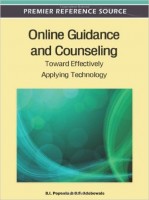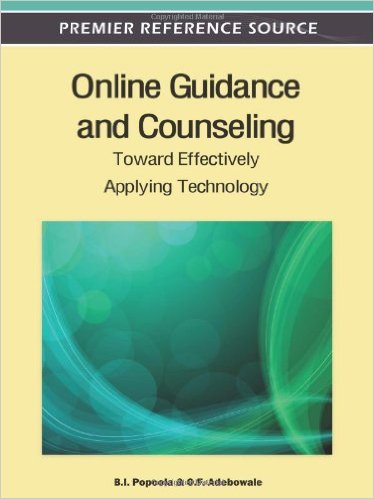 Editors: Bayode I. Popoola and Olusegun F. Adebowale
Editors: Bayode I. Popoola and Olusegun F. Adebowale
Publisher: Information Science Reference, an Imprint of IGI Global – 233 pages
Book Review by: Paiso Jamakar
Online education has become quite widespread in the last twenty years or so, and access to online face-to-face instruction is now available for a very large range of subjects and courses, including college-level ones.
This book focuses on online guidance and counseling, an area within online education. According to the editors, “it aims to present and explain current findings in online counseling and guidance interactions with a view to helping practitioners improve on their practices and to help counselors-in-training to take in the intricacies of online therapeutic intervention.”
“It will also help in charting a course of development online guidance and counseling in the developing areas of the world where poverty, corruption, and illiteracy is still rife.” They point out the “imperative” of providing services online due to the shortage of personnel to provide them face to face.
As to who are the beneficiaries of counseling, this book is not limited to a particular type or category of people or sector of society that would benefit. For example, for a guidance counselor in a school, the beneficiaries would be students.
As you can glean from the titles of chapters below, the beneficiaries or recipients of the guidance and counseling services are diverse: they are children and youth, recipients of therapy, users of medicines, and various others.
Twenty-six specialists in counseling and education from Nigeria and five other countries – Australia, Gambia, Kenya, the United Kingdom, and the United States contributed material to this book – mainly various case studies – which cover the following topics as revealed on its Contents pages:
- The Provision of Online Counseling for Young People
- Faceless Counseling: Trend of Technological Development
- Communicating Emotions through the Internet
- Ethical Issues in Online Counseling
- Intimacy and Relational Communication in Online Counseling
- Reaching Out Across the Virtual Divide; An Empirical Review of Text-Based Therapeutic Online Relationships
- Counseling in Pharmacy Practice: Exploring the Use of Online Counseling Interactions to Improve Medicine Use among People Living with HIV/AIDS
- The Evolution of Guidelines for Online Counseling and Psychotherapy: The Development of Ethical Practice
- Enhancing the Helper–Helpee Therapeutic Relationship and the Client’s Desirable Change in Online Counseling
- Online Counseling for Children and Young People; Using Technology to Address the Millennium Development Goals in Nigeria
- Equipping the Online Counselors-in-Training: Between Theory and Practice
- Is There Anybody Out There? The Role of Technology in Supporting Counselors and Therapists
- Self Disclosure in Online Counseling
- The Challenges of Online Counseling in a Developing Country
The chapters are very well organized, with the following features arranged in order of presentation:
- Abstract
- Introduction
- Background to the Study
- Discussion of Various Relevant Topics
- Conclusion
- References
- Additional Reading
- Key Terms and Definitions
Let’s take a look at chapter 3, Communicating Emotions Through the Internet, written by Bonko Adepeju Omoteso.
In his Abstract, the author asserts that the Internet is an effective medium of communicating emotions. He defines the Internet as a worldwide group of connected computer networks by which information is shared by users. He writes that there are many, many definitions of the word ‘emotion’ and cites one psychologist who once identified 92 distinct definitions.
He continues by writing that emotions can be communicated face-to-face, via the phone and via other electronic media such as movies, radio and television, and in recent decades, the Internet. He cites some specific tools for communicating emotions through the Internet, naming: email, chat, and FTP (file transfer protocol).
Omoteso then lists and discusses the items below in the topic Factors Associated with Emotional Ccommunications on the Internet and Their Advantages. (And we must add, disadvantages):
- Disinhibition Effect – people are more uninhibited to say things on the Internet than they do so in person to a group or face to face to a single individual
- Dissociative Anonymity – people feel free to say things on the Internet because they are unknown to others. “You don’t know me” is their attitude on the Internet.
- Invisibility – Most means of communication on the Internet do not show a person’s face, so invisibility gives them courage to go to places and do things they otherwise wouldn’t.
- Solipsistic Introjection – is the unconscious adoption of the ideas or attitudes of others. People imagine and create in their minds a voice and a face of another person they are communicating with, particularly empathizing with, on the Internet.
- Minimizing Authority – online, a person’s status, position, and other characteristics in their offline life is very often not known to others. He or she may even be the president of a country. To an online audience, that is not known, and of limited impact or influence.
In the topic that follows, Personality Variable and Emotional Communication Through the Internet, the author writes, based on studies by psychologists, that the strengths of defense mechanisms and tendencies toward inhibition and expression vary great among people. On the Internet, people present themselves the way they want to present themselves, without inhibitions.
“They may have more chances to convey thoughts and emotions and go ‘deeper’ than the seemingly superficial persona of everyday living,” he explains.
And in the last topic prior to the Conclusion, Criticisms of Communicating Emotions Through the Internet, Omoteso states that online communication such as emailing has been criticized for not adequately conveying emotions because of lack of facial expression, body language, and tone of voice. Also, many people are not as good communicating with written words as they are through speaking.
In his Conclusion, the author states that despite its limitations, it has been adequately shown that communicating emotions through the Internet and its various means such as email, chat, and others, is possible.
This is a well documented book with a lot of cases and research studies that back up the points that the various authors of the chapters make in it.
Editors:
Bayode I. Popoola is a professor of guidance and counseling in the Department of Educational Foundations and Counseling, Faculty of Education, at Obafemi Awolowo University in Ile-Ife, Nigeria. He specializes in school and adolescent counseling. He is currently chairman of the Postgraduate Committee of the Faculty
Olusegun F. Adebowale is an assistant lecturer of guidance and counseling in the Department of Educational Foundations and Counseling, Faculty of Education, at Obafemi Awolowo University in Ile-Ife, Nigeria. He majors in technology in counseling with special emphasis in online counseling. He is also a doctoral student in the same department.
Contributors:
David Akinlolu Adeyemo, Margaret O. Afolabi, Roland Chukwudi Agokei, Akinjide Gabriel Akintomide, Kate Anthony, Oladipo Babalola, Marilyn Campbell, Mary Esere, Kevin Glasheen, Stephen Goss, Terry Hanley, Adeyumi, Ibukunoluwa Idowu, Maureen C.Kenny, Olugbenga David Oja, Onijuni Olufemi Olatumide, Omoniyi J. Ola-Olorun, Bonke Adepeju Omoteso, Joshua Adebisi Omotosho, Susan Pattison, D’Arcy Reynolds, Maggie Robson, Maria Fernanda Santacruz, Aaron Sefi, and Adeola Shobola.







